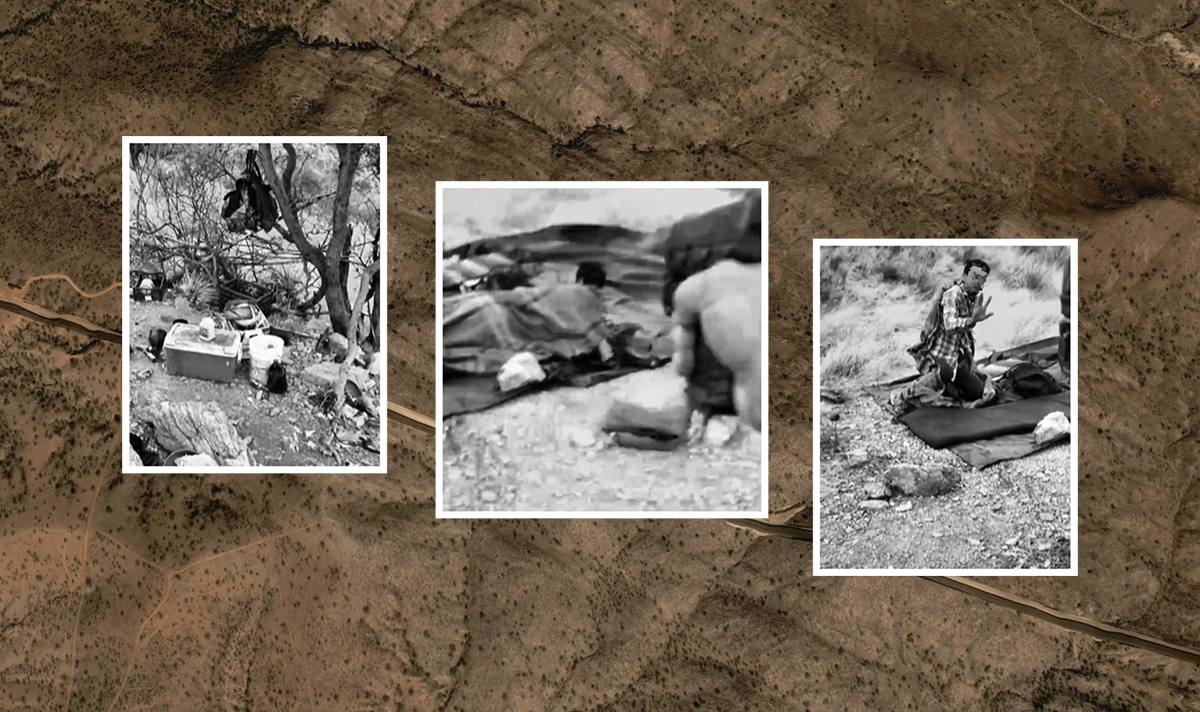Geolocating Mexican Sicarios in Chihuahua
Background information
On April 08 2015, the person behind the “La Polaka” Youtube profile posted this video (YouTube). It features an unidentified cameraman walking alongside a resting convoy of about 15 vehicles and 50 heavily armed men wearing assault gears, military fatigues or civilian clothing. As the cameraman is cheering the column, radio communications can be heard between a group leader and “Meny” – likely an advanced element of the commando, scouting for possible enemies or security forces. One can hear the cameraman repeating “Animo, sicarios” which can be translated as “let’s go get them, hitmen”. The scene was reportedly filmed during late fall 2014, prior to clashes with a rival gang. Based on what can be observed in the video, it is possible to pinpoint the exact location of the deadly convoy.
Locating the video
“La Polaka” mentions that the video took place in Chihuahua and indications for the towns of Guachochi and Creel can be seen at 02:00 in the video.
The most direct route connecting Guachochi and Creel is a paved road with a length of 158 kilometres. Considering that the indication for Creel points towards the left side of the screen and that Guachochi is on the opposite side, it can be deducted that the filming location is on the Western side of the main road linking both towns.
By looking at the featured environment, it appears that the location is at a T-junction, with the convoy resting on a paved secondary route connecting to the Guachochi-Creel main road. As there are very few similar sites along the way, the terrain at 27.29842, -107.5267 offers a similar landscape to what can be observed in the video.
During the first minute of the video, the cameraman is filming the tail end of the convoy. One can see that the road is going into a steep curve (1) and that rock walls made from excavation (2) are on both sides of the road. A serie of building (3-4-5) and vegetation (6) can also be perceived on top of the small cliff on the right-hand side of the road from the cameraman point of view – which is conform with the features of the commercial imagery.
As the cameraman is moving towards the head of the convoy, the left side of the road is open ground (7) while the right side presents more dense vegetation (8). Considering that the vehicles in the convoy have an average length of six meters, with an average five meters of spacing between them, the resting convoy would occupy approximately 160 meters, which is consistent with what can be measured on Google Map.
At the end of the video, the lead elements of the convoy are seen next to a T-junction at the main Guachochi-Creel road. At the intersection, there are a road sign (9) and a building of rectangular shape (10). However, the billboard (11), also located on the far side of the road, is not present in any commercial imagery available. According to Google Earth, the last satellite images accessible of the area were taken in June 2010, four years before the video was taken. This certainly explains why the billboard can be seen in the video, but is missing from the satellite photo.
Analysis
Online medias have widely discussed this video. Although no one has been able to positively identify to which group the convoy of sicarios belongs to, they have been linked to different clashes that occurred around the time the video was recorded. Proceso specified that a couple of vehicles seen in the video were later found on the location of a November 2014 violent shootout in Samachique, Chihuahua, in which dozens of people were killed. InSight Crime further indicates that some of the sicarios pictured in the video were found dead on the site of a March 2015 gunfight in a ranch close to this area.
During fall 2014, armed factions of the Sinaloa Cartel (Gente Nueva) and the Juarez Cartel (La Linea) were still fighting in Southern Chihuahua over trafficking routes – with the Sinaloa Cartel having the upper hand. Experts also suspect that the fighting was linked to control over resource extraction. In the recent years, drug trafficking organizations in Mexico have started to diversify their business activities and turned their attention to mining and energy industries. It is thus believed that the commando outlined in the video belongs to either the Gente Nueva or the Juarez Cartel.
Gente Nueva’s soldiers originate from the Mexican security forces and are considered to be an “elite force” within the Sinaloa Cartel. They are known to operate mostly in military uniforms but in several cases, they have been seen wearing civilian clothing.
La Linea is also composed of ex-members of the Mexican security forces but tend to wear civilian clothes, with only a few individuals dressing in military fashion. In 2015, La Linea reportedly separated from the Juarez Cartel and formed the Nuevo Cártel de Juarez, thus indicating the influence of the group in the area.
Nevertheless, these images offer a rare insight into the crude world of armed enforcers and are a cold reminder of the level of freedom and firepower these groups still retain in some rural parts of Mexico.
Since Felipe Calderón became President of Mexico in 2006, drug-related violence skyrocketed in the country. Following his decision to deploy 50, 000 soldiers by 2012 on the Mexican streets, the number of homicides tripled from 10, 452 in 2006 to 27, 213 in 2011. As Mexico and the US went after heads of cartels, they atomised the main ones into smaller entities that grew larger. Higher rates of crime were thus the direct outcome of inter- and intra-cartel gunfights as well as battles between Mexican security forces and drug trafficking organizations. The new President, Enrique Peña Nieto, has vowed to not repeat the mistakes of his predecessor. Yet events such as the 2015 Hollywood-style escape of El Chapo and the disappearance of 43 students in the city of Iguala back in 2014 have shown the extent to which cartels have penetrated the Mexican government at all levels. The only positive note was the rapid recapture of El Chapo, which has been hailed as a victory for the Mexican fight against drug trafficking organizations. This view however underestimates the rise of new and smaller cartels, such as the Jalisco New Generation Cartel, which according to experts are the future of drug trafficking in opposition to large and centralized groups like the Sinaloa cartel.
Sources
http://www.insightcrime.org/news-analysis/new-video-appears-of-hit-squad-in-mine-rich-mexico-region
http://www.jornada.unam.mx/2014/11/04/politica/010n2pol
http://www.proceso.com.mx/?p=400706
http://archive.elpasotimes.com/news/ci_27916069/video-narco-gunmen-convoy-was-filmed-last-year/
https://www.youtube.com/watch?v=QQ2j5oeHsd4
http://www.lapolaka.com/animo-sicarios/
La Linea
http://www.narcoviolencia.com.mx/2015/06/fotos-al-igual-que-los-zetas-y-el-cjng.html
Gente Nueva
http://www.narcoviolencia.com.mx/2015/02/la-gente-nueva-sus-origenes-del.html
By Vince. Edited by Aliaume Leroy











